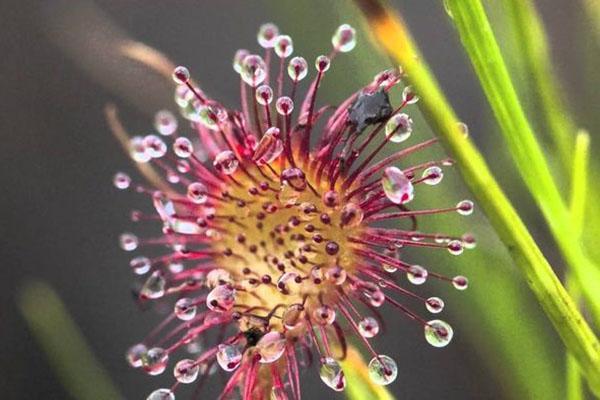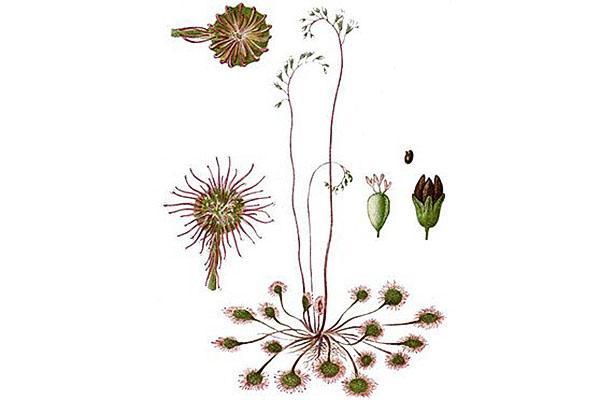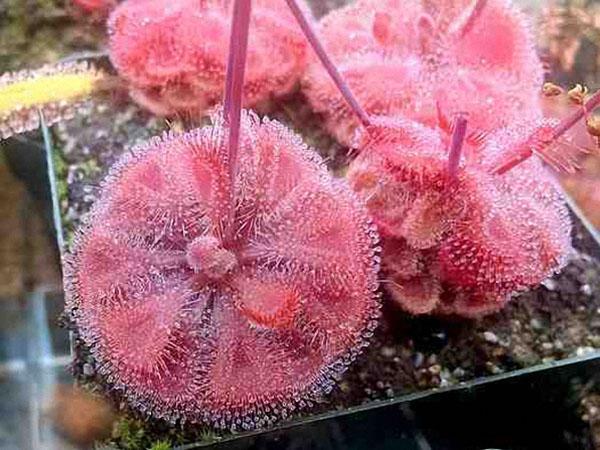Proper care of a sundew at home
 Perennial grasses of the Rosyankov family are grown as ornamental plants. They are valued by flower growers for their unusual appearance and ability to feed on insects. Caring for a sundew at home is quite simple if it is possible to reproduce the natural habitat.
Perennial grasses of the Rosyankov family are grown as ornamental plants. They are valued by flower growers for their unusual appearance and ability to feed on insects. Caring for a sundew at home is quite simple if it is possible to reproduce the natural habitat.
It should be borne in mind that the halo of sundew habitat is great, from tropical forests to swamps of a temperate climatic zone. Each species is adapted to specific temperature and humidity conditions. Sundews growing in areas with a cold climate need a dormant period with low temperatures, and tropical varieties can do without it all year round.
External signs and features of the plant

Species traits
 Despite the variety of species, the structure of sundews has common features.
Despite the variety of species, the structure of sundews has common features.
- The leaves are rounded or oblong, collected in a basal rosette, have a length of 50 mm to 0.5 meters, depending on the variety. On the surface of the leaf, there are hairs, at the ends of which drops of sticky secretion accumulate, which looks like dew.
- The root system is fragile, short in length, since in its natural environment the plant exists on poor soils, unable to supply it with a full set of nutrients.
- The plant throws out tall peduncles so that insects have the opportunity to pollinate them without the risk of dying. Flowers are tied to the stem above the trap leaves in early spring. The colors can be pink, purple or creamy.
- The fruits are formed after the end of the flowering period and the fall of the petals. Sundew seeds are under a thin layer of skin, there is no pulp.
In the process of evolution, plants have learned to extract additional food from insects, which are caught in an unusual way.
Who and how the sundew hunts
 Carnivorous plants have developed ways to lure and kill their prey with leaf traps. The larger the leaf, the larger the insect it is able to capture. These can be small flies, moths, mosquitoes, flies, and in some cases, dragonflies or butterflies. Precisely in order to observe how the sundew hunts, it is worth having an unusual flower.
Carnivorous plants have developed ways to lure and kill their prey with leaf traps. The larger the leaf, the larger the insect it is able to capture. These can be small flies, moths, mosquitoes, flies, and in some cases, dragonflies or butterflies. Precisely in order to observe how the sundew hunts, it is worth having an unusual flower.
 The plant produces a thick secretion that attracts insects. Drops of paralytic substance accumulate at the tips of the glandular hairs, abundantly covering the edges and upper surface of the leaves. A victim who is captured is bogged down in a sticky substance and has no chance of being saved.
The plant produces a thick secretion that attracts insects. Drops of paralytic substance accumulate at the tips of the glandular hairs, abundantly covering the edges and upper surface of the leaves. A victim who is captured is bogged down in a sticky substance and has no chance of being saved.
 The sheet is folded. With the help of food enzymes, the plant dissolves the chitinous surface of the victim's body, breaks down to the simplest substances. This is how the sundew obtains the vital nitrogen, phosphorus, magnesium, potassium, sodium.
The sheet is folded. With the help of food enzymes, the plant dissolves the chitinous surface of the victim's body, breaks down to the simplest substances. This is how the sundew obtains the vital nitrogen, phosphorus, magnesium, potassium, sodium.
Dewdrop grows well on acidic soils. For its cultivation, it is not advisable to use ceramic pots, which over time contribute to the alkalization of the soil.
Growing conditions
Dewdrop is an unusual plant that has developed adaptive mechanisms for survival in rather harsh conditions. These are depleted soils, often high humidity, limited lighting.It is necessary to take into account the needs of the plant and create an appropriate habitat.
The soil
 It is not recommended to use traditional flower soil for sundew. A depleted, acidic substrate is considered most suitable. The soil for the sundew should be very light and retain moisture well. These requirements are met high peat Fasco, TP Pelgorskoe (Morris Green, pH 2.8-4.0), Agrobalt-V.
It is not recommended to use traditional flower soil for sundew. A depleted, acidic substrate is considered most suitable. The soil for the sundew should be very light and retain moisture well. These requirements are met high peat Fasco, TP Pelgorskoe (Morris Green, pH 2.8-4.0), Agrobalt-V.
Self-prepared formulations are also suitable:
- coarse sand mixed with peat, taken in equal proportions;
- peat combined with seramis granules;
- The best option is sphagnum moss.
To avoid the gradual alkalization of the soil, a pot is selected from glass or plastic, excluding ceramics.
Humidity
The humidity required by the sundew must be at least 60%. To do this, the pot with the plant is immersed in a deep pan, in which the water level must be at least 1 cm of water. Distilled or settled rainwater is used to moisten the soil.
If possible, indoor sundew is grown in aquarium terrarium type, the bottom of which is lined with moss.
It should be borne in mind that prolonged waterlogging of the soil leads to decay of the roots. To avoid this, not expanded clay is used as a drainage material, but coarse quartz sand.
With a lack of lighting, the sundew stops producing dew and growth slows down.
Lighting
 The plant is demanding on the length of daylight hours, in summer the duration should be at least 12 hours, in winter - 8 hours. The plant does not tolerate bright sun, which burns the leaves, drying out the nectar that attracts insects. And in the absence of light, the plant dies quickly enough.
The plant is demanding on the length of daylight hours, in summer the duration should be at least 12 hours, in winter - 8 hours. The plant does not tolerate bright sun, which burns the leaves, drying out the nectar that attracts insects. And in the absence of light, the plant dies quickly enough.
Therefore, the best option for planting a sundew is to place the plant pot on a window located in the east or west, where sunlight hits in the morning or evening. In cloudy weather or in winter, additional lighting is used.
Temperature
The comfortable temperature range for a plant is from 5-6 degrees in winter to 30 degrees in summer. A deviation from this amplitude in one direction or another leads to a damping of growth and rapid death of the plant.
For tropical species during the growing season, a temperature of +30 is permissible, in the winter period, 14-16 degrees. For plants from the temperate zone, a favorable temperature in the warm season is 22-25 degrees, in winter - 7-12 degrees.
The balance of humidity and temperature is the main condition for maintaining heat exchange in plants.
Food
You can decide that caring for a sundew at home cannot be complete in the absence of insects. But it is not so. The plant will not die, but only slow down its growth. But even so, you should abandon the traditionally accepted methods of feeding.
In summer, it is best to expose the sundew to the open air, where it can hunt. In winter, midges living in pots with indoor flowers can serve as an additional source of food for sundew at home. If the growth retardation is particularly noticeable, then you can feed the indoor predator with dried flies from the pet store.
Even a predatory plant cannot resist the invasion of aphids. If a pest colony is found, it is necessary to immediately treat the affected areas with an insecticide.
Sundew care at home
 In the absence of experience, it is better to choose a variety that does not require a too delicate approach. The most problem-free is the Cape sundew, which tolerates dry air well in apartments with central heating. Most varieties are more demanding in terms of growing rules. The result depends only on how to care for the sundew at home:
In the absence of experience, it is better to choose a variety that does not require a too delicate approach. The most problem-free is the Cape sundew, which tolerates dry air well in apartments with central heating. Most varieties are more demanding in terms of growing rules. The result depends only on how to care for the sundew at home:
- Due to the weak root system, a 10 cm deep container is sufficient for the plant. The best option is an aquarium / terrarium.On the surface of the soil, it is advisable to lay out a litter of moss to retain moisture.
- A container with a plant is placed outside direct sunlight, and in winter, away from central heating batteries. It is necessary to monitor compliance with the temperature regime, sufficient air flow.
- Watering is carried out regularly, constantly keeping the soil moist. Use only settled or distilled water. Water the home sundew under the root, preventing the flow of water from entering the leaves.

- In case of insufficient lighting, the plants are supplemented. In summer, on the contrary, they shade from too bright sunlight.
- It is unacceptable to water the sundew with tap water, or to apply liquid top dressing to the soil. The lack of nutrition is compensated for with the help of dried insects.
- The only insect that the sundew cannot handle is aphid. The affected areas should be treated with Fitoverm, which is diluted in a volume of 5 ml in 1 liter of water. The plant is sprayed and isolated for 24 hours with a plastic bag.
- Rosyanka lives on average in a room for 3 years. Therefore, you should take care of the separation of young shoots in advance to form new bushes.
- To pollinate plants without the participation of insects, you should rub the peduncles together, or transfer the pollen with a brush. Some types of sundew pollinate themselves.
You can determine the presence of problems by changing the color of parts of the plant and the disappearance of transparent drops from the surface of the leaves.
With strong waterlogging, an unscheduled transplant is done to prevent root rot. All affected processes are removed.
Transplant and breeding
It is recommended to transplant a plant every 2 years in the spring, when the sundew enters a phase of active growth. After transplanting, it is better to remove the peduncles so that the weakened plant does not spend additional energy on their development.
Sundew can be propagated in several ways:
- Dewdrop from seeds at home is grown from its own seed or purchased in a greenhouse. This method is the most laborious and time consuming. The seeds are planted directly in the moss, covered with foil or glass and kept at a temperature of at least 25 degrees for about a month. After the appearance of several leaves, transplantation is carried out to a permanent place. Within four months, the plant begins to form a stem. Only experienced gardeners can breed sundew with seeds.

- A healthy bush can be propagated by division. Lateral shoots are carefully separated from the main stem along with the roots and placed in separate small containers with water or moss. After rooting, they can be transplanted into a pot or terrarium for full development. The division is recommended to be carried out during a planned transplant, so as not to injure the plant again.
- When grafting, a few centimeters are cut off from the trunk and the resulting seedling is placed in water or moss until roots are formed. Care must be taken to ensure that the root does not rot in the water. Then the seedling is transplanted into the ground.
Following the above recommendations will allow you to both grow a sundew from seeds and propagate an existing bush using cuttings or shoots. If you follow the basic rules and maintain the parameters of temperature, lighting and humidity at the proper level, then the plant will not cause much trouble.